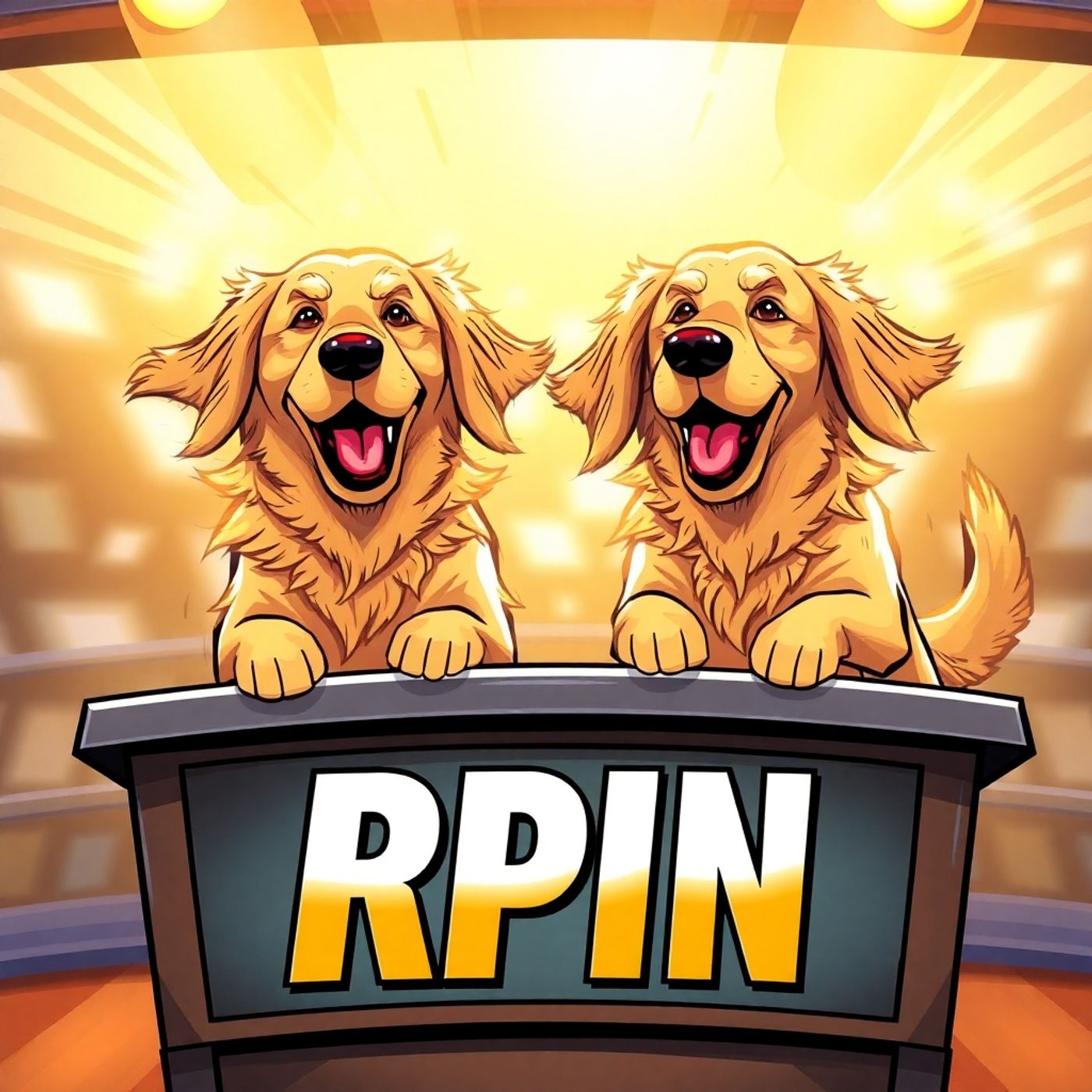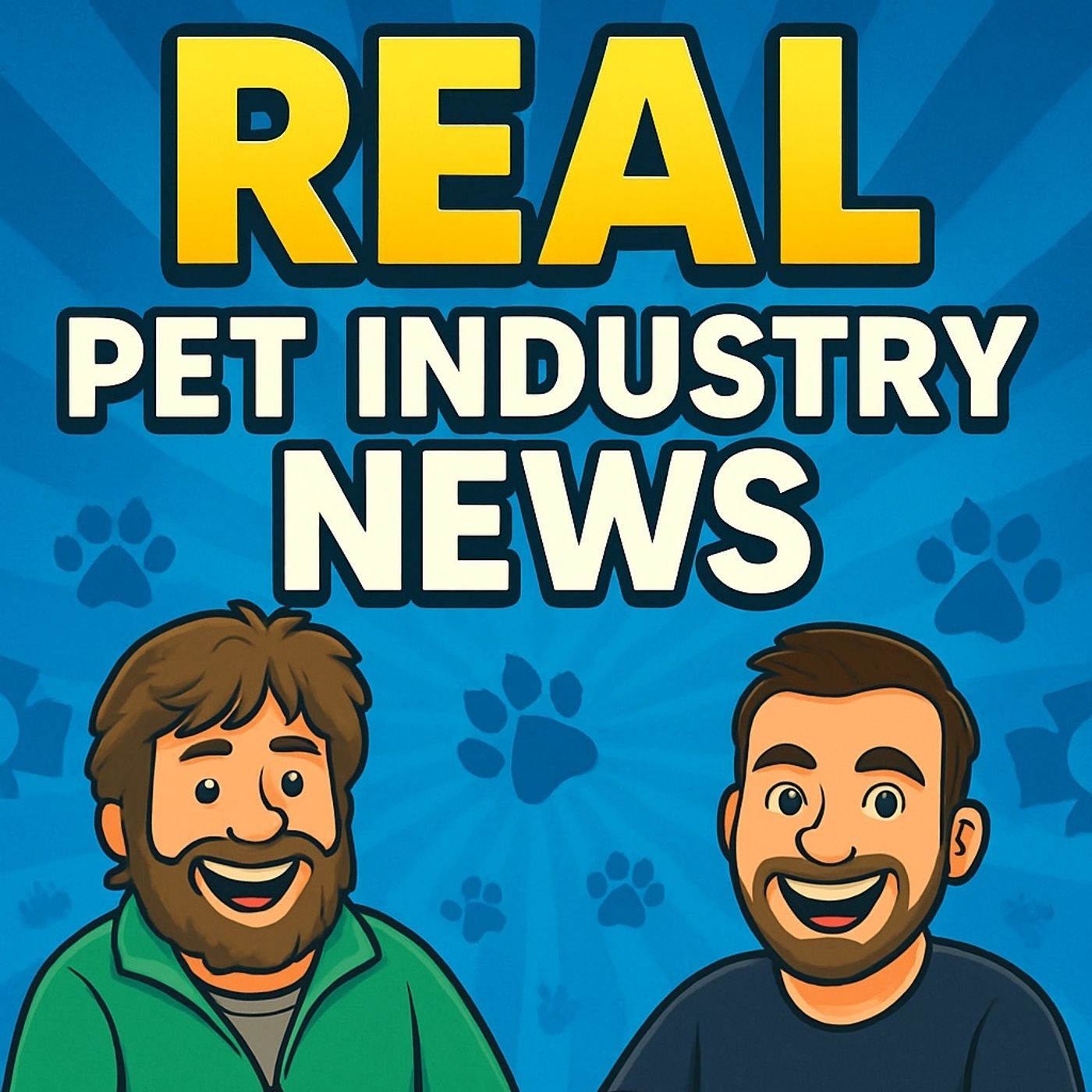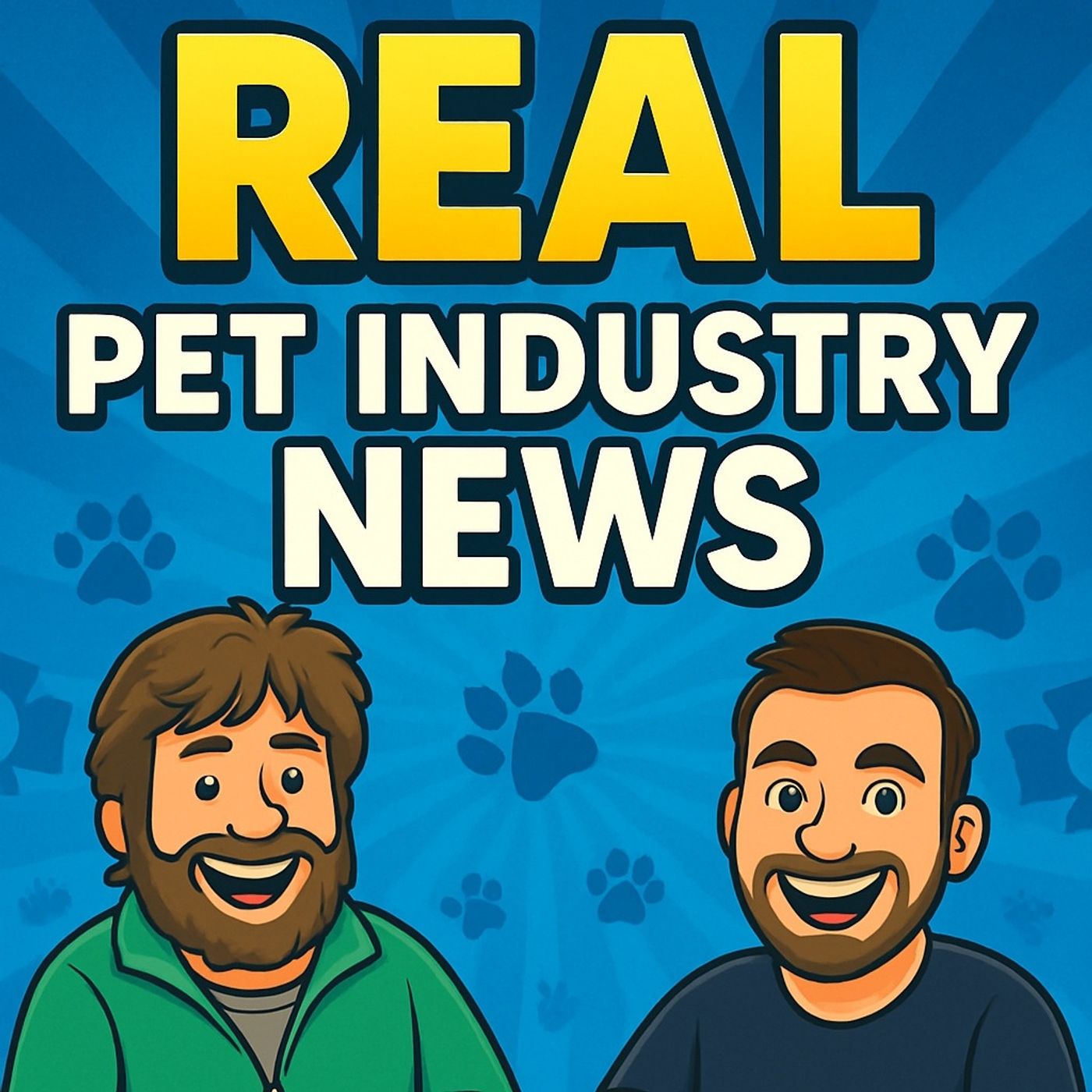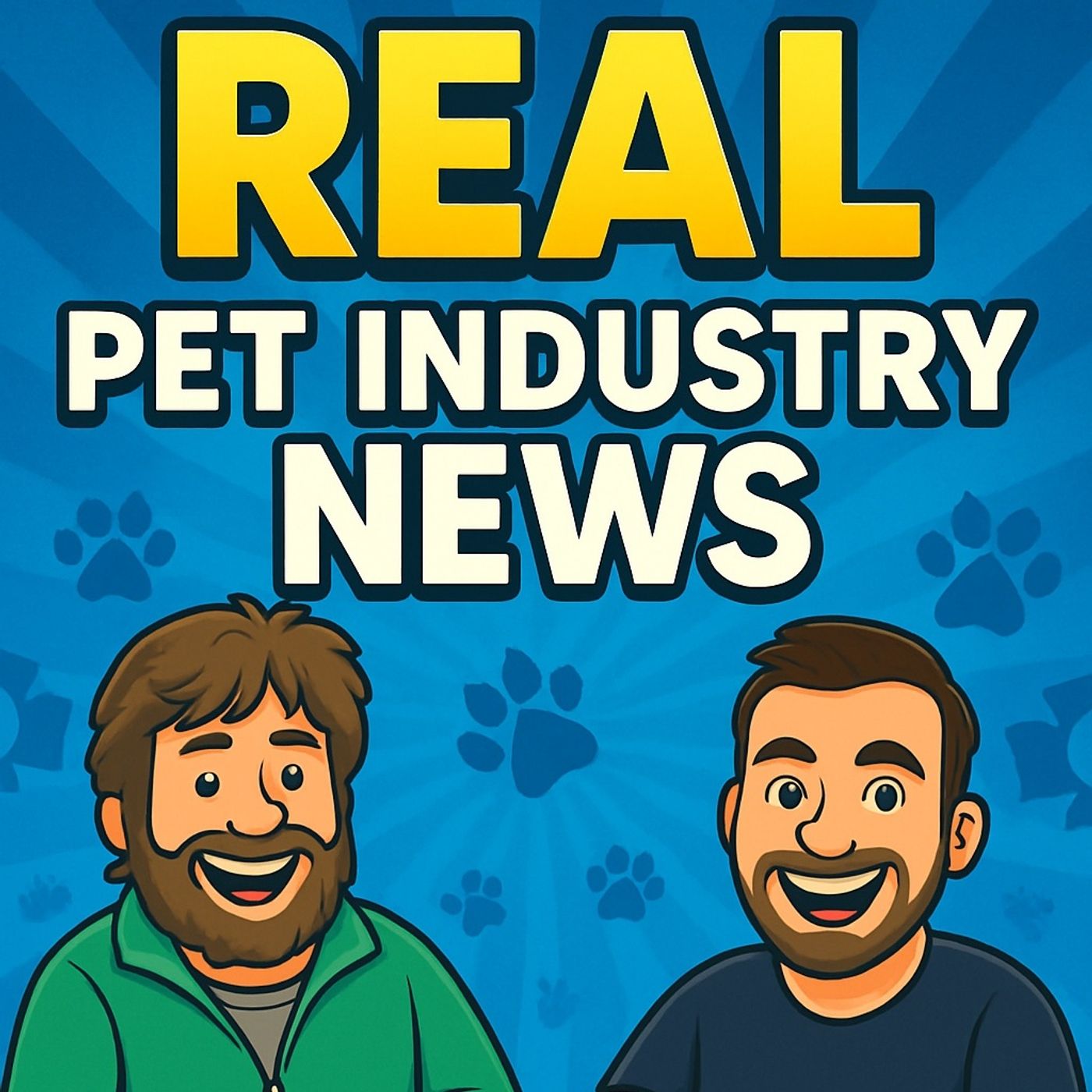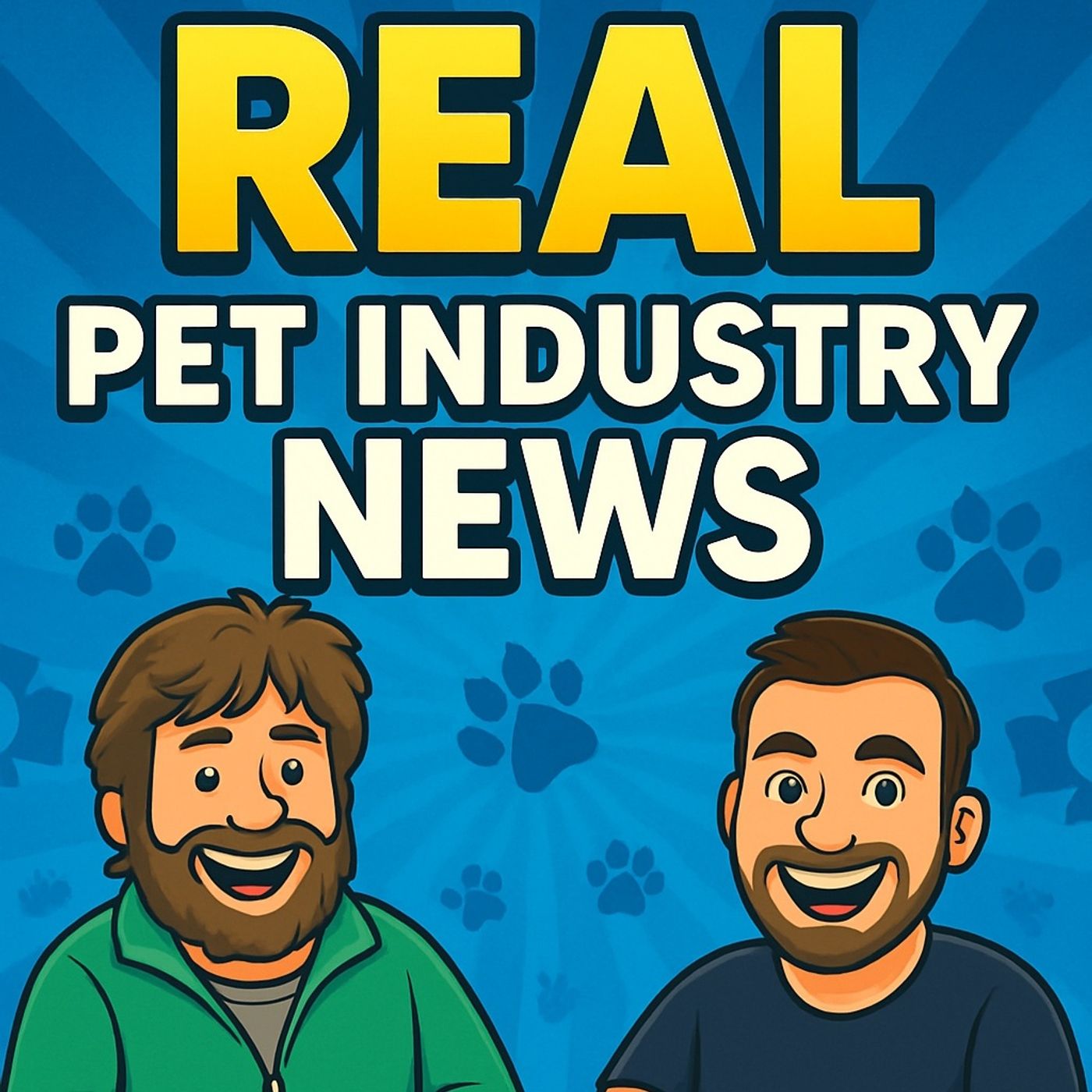Discover Real Pet Industry News
Real Pet Industry News

Real Pet Industry News
Author: Clayton Payne and Sam Muelas
Subscribed: 0Played: 1Subscribe
Share
© Real Pet Industry News
Description
Real Pet Industry News brings you raw, unfiltered commentary on the latest trends, controversies, and innovations shaping the pet industry. Hosted by Clayton Payne (Pet Business Disruptors) and Sam Muelas (Dog and Cat Nutrition on YouTube), this podcast cuts through the noise to deliver real talk on everything from pet food scandals to game-changing business moves. Whether you're a pet industry pro, entrepreneur, or just a passionate pet owner, Clayton and Sam break it all down with expert insight, sharp opinions, and no-nonsense discussions.
41 Episodes
Reverse
In this episode, Clayton and Sam discuss the current state of the pet food market, focusing on Purina's mixed performance and the challenges faced by veterinary care in the UK. They explore the implications of rising prices, lack of transparency, and the impact of corporate ownership on independent practices. The conversation also delves into regulatory changes proposed by the CMA aimed at improving price transparency and competition in the veterinary sector.takeawaysPurina's sales have dropped, but they are gaining market share.The pet food market is experiencing mixed growth, particularly in Europe.High veterinary prices have risen significantly over the years.Lack of transparency in veterinary pricing is a major concern.Corporate vets charge more than independent practices.Pet owners may pay double for medicines at vets compared to online.The CMA is proposing mandatory price transparency for vets.Independent vets are struggling to compete with corporate practices.Regulatory changes may favor larger corporate veterinary practices.The market is increasingly dominated by a few major players.titlesPurina's Market Dynamics: A Mixed BagChallenges in Veterinary Care: Transparency and PricingSound Bites"Purina's pet care sales are down.""High prices have risen by 63%.""The CMA has written 21 proposals."
In this episode, Clayton and Sam discuss the current landscape of the pet food industry, focusing on the winners and losers. They explore the challenges faced by small independent retailers, the struggles of small D2C companies against larger competitors, and the inefficacy of traditional advertising methods. The conversation also touches on the rising costs of premium kibble and its impact on consumer choices, highlighting the need for innovative marketing strategies and the importance of education in advertising.takeawaysIndependent retailers are struggling due to rising costs and competition.D2C companies face challenges from larger competitors with more funding.Traditional advertising methods are becoming less effective.Education-based marketing is a long-term strategy that builds trust.Premium kibble prices are rising, affecting consumer choices.The pet food industry is evolving with changing consumer preferences.Small D2C companies need to find niche markets to survive.Independent retailers play a crucial role in product innovation.The market is increasingly becoming a pay-to-play environment.Consumer behavior is shifting towards more engaging and informative marketing.titlesNavigating the Pet Food Industry: Winners and LosersThe Struggles of Independent Retailers in Pet FoodSound Bites"It's a pay to play environment.""Kibble has crossed the £100 Rubicon.""The self-immolation of kibble."
In this episode, Clayton and Sam discuss the current landscape of the pet industry, highlighting the winners and losers, including veterinary practices, direct-to-consumer companies, and the rise of gently cooked pet foods. They explore the dynamics of veterinary diets, the influence of big box retailers, and the growing trust in creators over traditional companies. The conversation delves into the complexities of consumer trust, the need for a balanced ecosystem in pet retail, and the evolving preferences of pet owners.takeawaysVeterinary practices are oligopolistic and have raised prices without affecting margins.Direct-to-consumer companies are disrupting traditional pet food markets.Gently cooked foods are gaining popularity due to their convenience and appeal.Veterinary diets remain a trusted source for pet nutrition despite criticism.Big box retailers are expanding their pet product offerings significantly.Creators are becoming trusted sources of information for pet health and nutrition.Consumer trust in veterinarians is being challenged by online information.The pet food market is shifting towards more budget-friendly options.The ecosystem of pet retail needs to support both online and brick-and-mortar businesses.The influence of social media is reshaping consumer perceptions of pet food.Sound Bites"DTC companies are disrupting the market.""Creators are trusted more than companies.""People trust independence a lot more."
n this conversation, Clayton Payne and Sam discuss the marketing strategies and business models of Butternut Box, a prominent player in the pet food industry. They analyze the effectiveness of its marketing, the implications of its business model, and the competitive landscape it faces. The discussion also touches on the future of pet food innovations and insights from the recent Pats trade show, emphasizing the importance of innovation in the pet industry.takeawaysThe customer acquisition cost must be lower than customer value.Spamming the market is not effective marketing.Butternut Box's business model relies heavily on investor funding.Market penetration is crucial for brand visibility.Competition in the pet food industry is fierce and evolving.Retail strategies are essential for long-term success.Innovation is key to standing out in trade shows.The pet food market is influenced by consumer convenience.Investors are looking for significant returns on their investments.The future of pet food may shift towards more convenient options.titlesDisrupting the Pet Food MarketThe Marketing Dilemma of Butternut BoxSound Bites"It's impossible to compete against them.""They want an exit.""Has this ever been done before?"Chapters00:00The Marketing Landscape of Pet Food02:34Butternut Box: Market Penetration and Strategy05:05Profitability and Business Models in Pet Food07:36Competition and Market Dynamics10:35Future of Pet Food: Trends and Innovations13:01Insights from the Pats Trade Show
In this episode, Clayton and Sam discuss the shortcomings of marketing strategies in the pet food industry, particularly focusing on a recent ad campaign by Pure Pet Food that they find tone-deaf. They explore the importance of understanding consumer needs and the viability of new products, such as freeze-dried dog food and postbiotics. The conversation also highlights the challenges of educating consumers about new dietary options for pets and the necessity for targeted marketing strategies that resonate with specific consumer problems.takeawaysThe marketing in the pet food industry often misses the mark by focusing on the company's achievements rather than customer needs.Investors should be wary of companies that prioritize ego over product quality.Consumer education is crucial for new products like postbiotics and insect-based diets.The pet food industry sometimes advances innovations that do not resonate with consumers.Targeted marketing is essential; generic approaches waste advertising budgets.Understanding the differences between prebiotics, probiotics, and postbiotics is important for pet health.The viability of new pet food products depends on consumer acceptance and understanding.Companies need to drill down on their unique selling propositions to stand out.The pet food market is competitive, and companies must focus on specific consumer needs.Marketing strategies should prioritize consumer problems over company growth narratives.titlesThe Flaws in Pet Food MarketingConsumer Insights in the Pet IndustrySound Bites"The customer doesn't want insects.""Most dogs don't need probiotics.""They're talking about themselves, Clayton."
summaryIn this conversation, Clayton Payne and Sam discuss the evolving landscape of the pet food industry, focusing on the impact of regenerative farming practices, the scale of major companies, and the challenges faced by challenger brands. They explore the importance of branding and marketing strategies, the role of China in manufacturing, and the cultural differences in pet care that influence innovation in the industry.takeawaysRegenerative farming practices are being adopted in the pet food supply chain.The scale of major pet food companies is often underestimated.Challenger brands must find their niche to compete effectively.Branding and marketing are crucial for success in the pet food market.The veterinary prescription diet model is difficult to penetrate for new brands.China plays a significant role in pet product manufacturing but lacks innovation.Innovation in the pet industry often comes from Western markets.Cultural differences affect how pets are treated and marketed in different regions.Challenger brands should focus on a narrow offering before expanding.The average consumer's lack of education impacts their purchasing decisions.Sound Bites"Branding is very, very important.""The average consumer isn't educated.""The West is the best."Chapters00:00The Scale of Pet Food Industry Partnerships03:34Navigating Competition in the Pet Food Market08:21Branding and Marketing in Pet Food13:31The Role of China in Pet Industry Innovation
summaryIn this conversation, Clayton Payne and Sam discuss the evolving landscape of the pet industry, focusing on profitability, innovation in cat products, the challenges of raw feeding, consumer behavior in pet nutrition, and the importance of breed-specific nutrition. They also explore market gaps in pet food and supplements, innovative approaches to pet food, and the misuse of LinkedIn for product sales.takeawaysThere are many niches to explore in the pet industry.Premiumization of cat products is a significant growth area.Most new cat products will fail due to lack of innovation.Cats are sensitive to food temperature, affecting raw feeding.Consumer behavior towards cats differs from dogs, impacting nutrition choices.Breed-specific nutrition can address common health issues in pets.Market gaps exist for innovative pet food and supplements.Convenience and quality are key in pet food innovations.LinkedIn is not an effective platform for B2C product sales.Personal branding on LinkedIn should focus on industry-related content.titlesUnlocking Profitability in the Pet IndustryInnovating Cat Products for Modern ConsumersSound Bites"75% of new cat products will fail.""Your customers are not on LinkedIn.""It's not Facebook or Instagram."Chapters00:00Exploring Profitability in the Pet Industry02:26Innovations in Cat Products05:20The Shift Towards Cooked and Raw Pet Foods07:47Understanding Consumer Behavior in Pet Nutrition10:10The Potential of Breed-Specific Supplements12:45Identifying Gaps in the Pet Food Market15:16The Role of Convenience in Pet Food Innovations17:40Critique of LinkedIn as a Sales Platform for Pet Products
summaryIn this episode of Real Pet Industry News, Clayton Payne and Sam discuss JM Schmucker's recent financial performance, highlighting a significant decline in net pet food sales and the challenges faced by legacy brands like Milk Bones and Meow Mix. They explore the importance of innovation in the pet food industry, particularly for companies looking to remain relevant in a competitive market. The conversation also touches on the difficulties UK companies face when entering the U.S. market, insights from the SuperZoo event, and the evolving landscape of information channels in the pet industry, suggesting that podcasts and alternative media are becoming more influential than traditional outlets.takeawaysJM Schmucker's pet food sales have decreased significantly.Consumers are becoming more cautious with their spending.Legacy brands like Milk Bones need to innovate to stay relevant.The pet food market is shifting towards premium products.UK companies face challenges entering the U.S. market.SuperZoo is a key event for industry insights.Innovation is lacking in mainstream pet product shows.Holistic pet products are gaining traction in the market.Podcasts are becoming more influential than traditional media.The pet industry must adapt to changing consumer preferences.titlesThe Decline of JM Schmucker: What It Means for Pet FoodLegacy Brands in Crisis: The Case of Milk BonesSound Bites"Milk Bones need to up their game.""You need to team up with US distributors.""Media is almost already semi redundant."Chapters00:00JM Schmucker's Financial Performance07:48The Future of Legacy Brands10:22Challenges for UK Companies in the US Market12:10Insights from SuperZoo17:18The Shift in Information Channels
summaryIn this episode, Clayton and Sam discuss the evolving landscape of pet brand advertising, emphasizing the shift from traditional media to digital platforms. They explore the effectiveness of in-person events, the challenges faced by legacy brands like Nestlé Purina, and the importance of innovation in corporate strategy. The conversation also touches on recent acquisitions in the pet food industry, concerns about product quality, and the potential for holistic pet product offerings.takeawaysPet brands need to carefully consider where to allocate their advertising budget.Digital platforms like YouTube and Meta are becoming increasingly saturated.In-person events can provide significant marketing benefits for pet brands.Legacy brands face challenges in adapting to modern consumer preferences.Leadership changes at Nestlé Purina may impact their market strategy.Innovation is often stifled in large corporations due to risk aversion.Acquisitions in the pet food market can lead to a mix of quality brands.Quality concerns persist in many pet food products on the market.There is a growing demand for holistic pet products.A gap exists for wholesalers focusing on raw pet food and supplements.titlesNavigating Pet Brand Advertising StrategiesThe Shift from Traditional to Digital MarketingSound Bites"Where should pet brands advertise?""The product has to be good, obviously.""These brands are absolutely horrible."Chapters00:00Navigating Pet Brand Advertising Strategies02:40The Role of In-Person Events in Marketing05:32Challenges in Celebrity Endorsements07:53The Evolution of Pet Food Trends10:41Leadership Changes at Nestle Purina13:18Innovation vs. Market Preservation in Corporations15:42Acquisitions in the Pet Industry18:28Quality Concerns in Pet Food Brands20:56Opportunities for Holistic Pet Brands
summaryIn this conversation, Clayton Payne and Sam discuss the recent leadership changes at Pets at Home, the challenges facing the retail pet industry, and the need for innovation and better product offerings. They explore the competitive landscape, including the rise of online retailers and supermarkets, and the implications of Pets at Home's middle-market strategy. The discussion highlights the opportunities in the cooked food market and critiques the corporate mindset that may be stifling innovation. Ultimately, they emphasize the importance of Pets at Home's success for the broader pet industry.takeawaysPets at Home's recent leadership change reflects ongoing struggles in retail.The company has seen a decline in in-store sales and lowered profit projections.Retailers must adapt to online competition and changing consumer preferences.Pets at Home's product offerings are seen as middle-of-the-road and uninspired.Innovation is crucial for staying competitive in the pet industry.The cooked food market presents a significant opportunity for growth.Corporate culture can hinder innovation and responsiveness to market trends.Pets at Home needs to focus on better product ranges to attract customers.The competitive landscape includes supermarkets and online retailers like Amazon.The success of Pets at Home is vital for the overall health of the pet industry.titlesPets at Home's Leadership Shakeup: What It MeansRetail Challenges: Navigating the Pet Industry LandscapeSound Bites"They need to be more pro-innovation.""They are fighting battles on all fronts.""Corporate mindset is hindering innovation."Chapters00:00Leadership Shakeup at Pets at Home02:41Retail Challenges and Market Dynamics05:07Innovation and Product Offerings07:50Competition from Online and Supermarkets10:34Strategic Missteps and Market Positioning13:07The Need for Corporate Innovation15:49Future Directions for Pets at Home
summaryIn this episode, Clayton and Sam discuss various trends in the pet food industry, focusing on the viability of vegan pet food, the challenges of direct-to-consumer (DTC) models, the expectations of premium pet food, and the often overlooked needs of cat owners. They explore the disconnect between product offerings and consumer demands, particularly in the cat food market, and highlight the importance of understanding modern pet owners' preferences.takeawaysVegan pet food lacks a substantial market and is anti-biology.DTC pet food models may not be sustainable long-term.Premium pet food must justify high prices with quality ingredients.Cat products are often lumped with dog products, frustrating cat owners.The cat food market is growing, but quality offerings are limited.Consumers are increasingly hybrid in their pet food choices.Pet food marketing needs to align with modern consumer expectations.The pet food industry is highly competitive, driving up prices.Cat owners are becoming more discerning about their pets' diets.Retailers need to adapt to the changing landscape of pet ownership.titlesThe Future of Vegan Pet Food: A Dying Trend?Navigating the DTC Landscape in Pet FoodSound Bites"Vegan pet food needs to die.""Premium cable not being premium.""Cat consumers are grocery consumers."Chapters00:00The Vegan Pet Food Debate03:35The DTC Model in Pet Food06:37The Premium Kibble Conundrum14:10The Cat vs. Dog Product Dilemma16:33The Growth of Cat Products
summaryIn this episode, Clayton and Sam discuss the challenges facing the pet food industry, focusing on Nature's Menu's decline due to private equity influence, Bella and Duke's efforts to penetrate the veterinary market, and Canigan's acquisition of McAdams. They explore the implications of these developments for the future of pet food, particularly in the premium segment.takeawaysPrivate equity often harms the brands it acquires.Nature's Menu has strayed from its pioneering roots.Bella and Duke face challenges in educating vets about raw food.The veterinary market is heavily influenced by kibble companies.Logistical challenges exist for raw pet food in veterinary practices.Consumer trust in vets regarding nutrition is misplaced.The premium pet food market is shrinking due to trading down.McAdams' high prices may limit its market reach.The quality of ingredients in premium pet food is crucial.The future of premium kibble remains uncertain.titlesThe Downfall of Nature's MenuBella and Duke's Veterinary StrategySound Bites"They're just a cashback business.""Are they a premium company?""It's the easy thing to do."Chapters00:00The Downfall of Nature's Menu05:34Bella and Duke's Veterinary Strategy10:56The Challenges of Veterinary Nutrition12:59Kanigan Acquires McAdams: A Strategic Move?18:03Market Trends in Premium Pet Food
In this conversation, Clayton and Sam discuss the booming pet industry, focusing on the increasing populations of dogs and cats in the U.S. and the rising spending on pet care. They explore the changing demographics of pet owners, particularly the shift towards younger, male cat owners, and the implications for product development. The discussion then shifts to innovations in pet food, particularly the introduction of microbial proteins, and the challenges of consumer acceptance. Finally, they examine the future of vegan pet food and the sustainability of these trends in the market.takeawaysThe U.S. dog population is projected to reach 87.3 million by 2025.Pet owners are spending an average of $1,700 per year on their pets.Vet care accounts for a significant portion of pet spending, with dog owners spending more than cat owners.The demographics of pet owners are changing, with more young men adopting cats.There is a growing trend towards premiumization in pet products, especially for cats.Microbial proteins are emerging as a novel protein source in pet food.Consumer acceptance of new protein sources like microbial protein is uncertain.The vegan pet food market is not expected to grow significantly in the future.There is a difference in purchasing behavior between male and female pet owners.The sustainability of innovations in pet food is a key concern for the industry.titlesThe Booming Pet Industry: Trends and InsightsChanging Demographics: Who's Buying Pets Today?Sound Bites"$1,700 is nothing, is it?""America are expensive man.""Cheers, Duke."
summaryIn this episode, Clayton and Sam discuss the evolving landscape of the pet food industry, focusing on Bella and Duke's strategic shift towards veterinary practices, Untamed's supermarket debut, and the challenges faced by Purina in a changing market. They explore the implications of these developments for independent retailers and the overall pet nutrition landscape.takeawaysBella and Duke is trying to penetrate veterinary practices more aggressively.Sam expresses his discontent with Bella and Duke's past treatment of independent retailers.Vets for Pets represents a significant market opportunity for Bella and Duke.Untamed has successfully secured listings in major UK supermarkets.The cat food market is largely underserved, with many poor-quality options available.Purina is facing challenges due to soft demand for dog food and snacks.The pet food industry is shifting towards fresh and cooked products.Independent retailers need to focus on better quality products for cats.The market is changing, and companies need to adapt quickly to survive.There is a growing demand for high-quality pet nutrition among consumers.titlesBella and Duke's Strategic Shift in Pet FoodUntamed's Bold Move into SupermarketsSound Bites"Vets for Pets is huge.""Cats are underserved.""It's tough out there."Chapters00:00Bella and Duke's Strategic Shift08:53Untamed's Supermarket Debut22:28Purina's Struggles in a Changing Market
summaryIn this episode of Real Pet Industry News, Clayton Payne and Sam discuss the recent acquisition of Poppy and Ted by Vale Pet Foods, the challenges facing the pet retail market, the launch of Arden Grange's new vet care range, and the viability of veterinary prescription diets in a competitive landscape. The conversation highlights the complexities of the pet industry, including consumer behavior, market trends, and the impact of economic cycles on retail performance.takeawaysVale Pet Foods aims to expand its offerings with the acquisition of Poppy and Ted.The pet retail market is currently facing significant challenges and declining sales.Consumer behavior is shifting, with price sensitivity becoming more pronounced.The cyclical nature of economies affects consumer spending in the pet industry.Companies need to adapt their strategies to survive in a tough market.Bundling and discounting can be effective strategies for manufacturers.Arden Grange's new vet care range has received criticism for its quality.The veterinary prescription diet market is dominated by major players.Independent brands struggle to compete against established veterinary diets.The future of veterinary prescription diets for new entrants is uncertain.Sound Bites"Times are really, really tough.""Economies are cyclical.""It's a very tough market."Chapters00:00Vale Pet Foods Acquires Poppy and Ted08:58Challenges in Pet Retail16:35Arden Grange's New Vet Care Range
In this conversation, Clayton Payne and Sam discuss the evolving landscape of the pet food industry, particularly the rise of fresh pet food options like Blue Buffalo's Love Made Fresh. They explore market dynamics, consumer preferences, and the impact of cooked food on veterinary practices. The discussion also delves into competition among pet food brands, consumer awareness regarding ingredients, and the importance of niche marketing strategies in a crowded market.takeawaysBlue Buffalo is launching fresh food options to meet consumer demand.The pet food market is shifting towards fresh and cooked food.Veterinary practices may be impacted by healthier pet food options.Competition is intensifying among pet food brands.Consumer awareness of ingredients is crucial for brand loyalty.Niche marketing is essential for success in the pet food industry.The average consumer may not be as informed about pet food as industry insiders.Effective marketing strategies can help brands stand out.Fresh food options may cannibalize traditional kibble sales.The future of the pet food industry is likely to see significant changes.titlesThe Fresh Food Revolution in Pet CareNavigating the Pet Food Market LandscapeSound Bites"Blue Buffalo is entering fresh food.""The consumer nowadays is much more picky.""Most people don't read ingredients."
In this episode, Clayton and Sam discuss the recent administration of Kennelpack, a pet products wholesaler, and the implications for the pet industry. They explore the challenges faced by companies in the market, emphasizing the need for innovation and product development to stay relevant. The conversation shifts to the rising demand for fresh pet food and how retailers can adapt their strategies to meet consumer preferences. The hosts highlight the importance of continuous product innovation and the need for retailers to stock unique products that cannot be found in supermarkets.takeawaysKennelpack's administration highlights the challenges in the pet product market.The pet industry is facing tough times with declining sales.Continuous innovation is essential for businesses to thrive.Retailers should focus on stocking unique products.Consumer demand for fresh pet food is on the rise.Product development should not always mean reinventing the wheel.Taking small risks can lead to significant rewards in product offerings.Retailers need to adapt to changing consumer preferences quickly.The market is shifting towards fresh and convenient pet food options.Companies must keep their product ranges fresh to remain competitive.titlesKennelpack's Downfall: Lessons for the Pet IndustryNavigating Tough Times in Pet ProductsSound Bites"It's tough times in the pet industry.""I think it's a good product.""People want fresh food for their pets."Chapters00:00Kennelpack's Administration and Market Impact05:22Challenges in the Pet Product Industry10:30Innovation and Product Development in Pet Food15:24Consumer Demand for Fresh and Cooked Pet Food20:35Retail Strategies for Independent Pet Shops
In this conversation, Clayton and Sam discuss the evolving landscape of the pet food industry, particularly focusing on the rise of cooked pet food, the challenges faced by subscription services, and the significant opportunities within the cat market. They explore the implications of premium pricing, the disconnect in product offerings for cats, and the future of pet food brands as consumer preferences shift. The discussion highlights the need for better quality and more tailored products for cats, as well as the changing dynamics of pet ownership and spending habits.takeawaysRoyal Canin's new cooked food reflects industry shifts.Subscription services may struggle as retail options grow.Consumers prefer buying pet food as needed, not via subscriptions.The cost of premium pet food is a barrier for many owners.Hybrid feeding is becoming more common among pet owners.Competition will drive down prices in the pet food market.Brand equity in pet food is diminishing.Cat owners are increasingly seeking premium products.The pet industry has historically focused on dogs over cats.There is a growing demand for cat-specific products.titlesThe Future of Pet Food: Cooked vs. RawSubscription Services in the Pet Industry: A Dying Trend?Sound Bites"Cooked foods are terribly expensive.""Pure is the one I really don't like.""Cats are very underserved at the moment."Chapters00:00The Rise of Cooked Pet Food04:42The Subscription Model's Decline09:09Niche Markets in Pet Food13:04Brand Equity in Pet Food18:14The Cat Market's Untapped Potential22:42The Future of Cat Products
In this episode, Clayton and Sam discuss the recent controversies surrounding Nature's Menu and its shift in product quality, the dynamics of the pet food market, and the challenges faced by larger corporations in innovating effectively. They also explore the strategies of brands like Edgar and Cooper and the differences in consumer spending on pet food between the UK and the US.takeawaysNature's Menu has faced criticism for lowering the quality of its products.The pet food market is influenced by consumer education and pricing strategies.Innovation in pet food is lacking, with many companies sticking to outdated formulas.Big corporations struggle with bureaucracy, slowing down their ability to innovate.Edgar and Cooper's acquisition by General Mills marks a significant shift in the market.There is a growing demand for premium pet food in the US compared to the UK.Consumers are becoming more discerning about pet food ingredients.The pricing structure in pet food often leads to subpar products.Companies need to focus on quality rather than just price to succeed.The pet food industry is evolving, but many companies are lagging behind.Sound Bites"It's a disgrace.""It's a pricing decision.""Fire the C-suite altogether!"Chapters00:00Nature's Menu Controversy02:32Market Dynamics and Consumer Behavior05:13Innovation in Pet Food Industry07:36Challenges of Big Corporations10:31Pricing Strategies in Pet Food12:56Edgar and Cooper's US Launch15:38Comparative Spending on Pet Food
summaryIn this episode, Clayton and Sam discuss the rapid rise of Bugalugs in the pet industry, the implications of their brand presence in big box retailers like Aldi, and the potential risks to independent pet shops. They delve into the importance of brand perception and the long-term sustainability of businesses in the pet market. The conversation shifts to the role of scientific research in pet food, questioning the credibility of industry standards and the influence of large corporations. Finally, they explore recent innovations in pet products, highlighting both promising developments and marketing gimmicks.takeawaysBugalugs' growth may threaten independent pet shops.Brand perception is crucial for long-term success.Big box retailers can devalue premium brands.Scientific studies in pet food can be biased.Industry influence often overshadows genuine research.Probiotics may not be the best long-term solution.Innovation in pet products is essential for market growth.Consumer perception can be easily swayed by pricing.The pet industry is evolving with new voices and ideas.Marketing gimmicks can mislead consumers about product quality.titlesThe Bugalugs Dilemma: Growth vs. Brand IntegrityNavigating Brand Perception in the Pet IndustrySound Bites"Why would you compete?""It's the same brand!""Kick them out!"Chapters00:00The Rise and Risks of Bugalugs02:07Brand Perception and Market Dynamics07:32The Role of Institutions in Pet Food10:53Leadership Changes in Pet Food Industry25:26Innovations in Pet Products


